Frilled lizard
| Frilled lizard | |
|---|---|
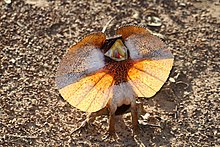
| |
| Scientific classification | |
| Domain: | Eukaryota |
| Kingdom: | Animalia |
| Phylum: | Chordata |
| Class: | Reptilia |
| Order: | Squamata |
| Suborder: | Iguania |
| Family: | Agamidae |
| Subfamily: | Amphibolurinae |
| Genus: | Chlamydosaurus Gray,1825 |
| Species: | C. kingii
|
| Binomial name | |
| Chlamydosaurus kingii Gray,1825
| |

| |
| Distribution ofChlamydosaurus kingii | |
Thefrilled lizard(Chlamydosaurus kingii), also known as thefrillneck lizard,frill-necked lizardorfrilled dragon,is aspeciesof lizard in thefamilyAgamidae.It is native to northernAustraliaand southernNew Guinea.This species is theonly memberof thegenusChlamydosaurus.Its common names come from the largefrillaround its neck, which usually stays folded against the lizard's body. It reaches 90 cm (35 in) from head to tail and can weigh 600 g (1.3 lb). Males are larger and more robust than females. The lizard's body is generally grey, brown, orangish-brown, or black in colour. The frills have red, orange, yellow, or white colours.
The frilled lizard is largelyarboreal,spending most of its time in trees. Its diet consists mainly of insects and otherinvertebrates.It is more active during thewet season,when it spends more time near or on the ground, and is less observed during thedry season,during which it seeks shade in the branches of the uppercanopy.It breeds in the late dry season and early wet season. The lizard uses its frill toscare offpredators anddisplayto other individuals. The species is considered to be ofleast concernby theInternational Union for Conservation of Nature.
Taxonomy[edit]
British zoologistJohn Edward Graydescribed the frilled lizard in 1825 asClamydosaurus kingii.He used a specimen collected by botanistAllan CunninghamatCareening Bay,off north-western Australia, while part of an expedition conducted by CaptainPhillip Parker KinginHMSMermaid.[2][3]The generic name,Chlamydosaurus,is derived from theAncient Greekchlamydo(χλαμύς), meaning "cloaked" or "mantled", andLatinsaurus(sauros), meaning "lizard".[4]The specific name,kingii,is a Latinised form of King.[5]It is the only species classified in its genus.[6]
The frilled lizard is classified in the familyAgamidaeand the subfamilyAmphibolurinae.Itsplitfrom its closest living relatives around 10 million years ago based on genetic evidence.[7]A 2017mitochondrial DNAanalysis of the species across itsrangerevealed three lineages demarcated by theOrd Riverand the southeast corner of theGulf of Carpentaria(Carpentarian Gap). One lineage ranged acrossQueenslandand southernNew Guineaand issisterto one that ranged from western Queensland to the Ord River. The ancestor of these two split from a lineage that populates theKimberley.Frilled lizards entered southern New Guinea possibly around 17,000 years ago during a glacial cycle, when sea levels were lower and a land bridge connected the island toCape York.The study upholdsC. kingiias one species with the different populations being "shallowallopatricclades".[8]
The followingcladogramis based on Pyron and colleagues (2013).[9]
| |||||||||||||||||||
Description[edit]
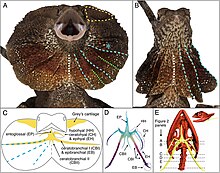
The frilled lizard and grows to a total length of around 90 centimetres (35 in) and a head-body length of 27 cm (11 in), and weighs up to 600 g (1.3 lb).[8][10][11]It has a particularly large and wide head; a long neck to accommodate thefrill;long legs and a tail that makes most of its total length.[6][10][12]The species issexually dimorphic,males being larger than females[8][10]and having proportionally bigger frills, heads and jaws.[13]The corners of the frilled lizard's eyes are pointed and the rounded nostrils face away from each other and angle downwards. Most of the lizard'sscalesarekeeled,having a ridge down the centre. From the backbone to the sides, the scales alternate between small and large.[6]
The distinctive frill is a flap of skin that extends from the head and neck and contains several folded ridges. When fully extended, the frill is disc-shaped and can reach over four times the length of the animal's torso in diameter, or around 30 cm (12 in) across. Otherwise it wraps around the body.[14][15][16]The frill is laterally symmetrical; the right and left sides are attached at the bottom in a V-shape, and cartilage-like connective tissue (Grey's cartilage) connects the top ends to each side of the head near the ear openings.[12][14]The frill is supported by rod-likehyoid bones,and is spread out by movements of these bones, the lower jaw and Grey's cartilage.[14]This structure mainly functions as athreat displayto predators and for communication between individuals.[15]It can also act as camouflage when folded, but this is unlikely to have been a consequence ofselection pressure.[15]The frill may be capable of working like adirectional microphone,allowing them to better hear sounds directly in front of them but not around them.[17]There is no evidence for other suggested functions, such as food storage, gliding or temperature regulation.[15]
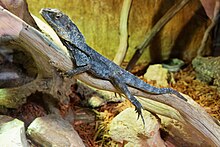
Frilled lizards vary between grey, brown, orangish-brown, and black dorsally, the underside being paler white or yellow. Males have a dark belly but a lighter chest. The underside and lateral sides of the species are sprinkled with dark brown markings that merge to create bands on the tail.[6]The colours of the frills vary based on range; lizards west of the Ord River have red-coloured frills, those living between the river and the Carpentarian Gap have orange frills, and those east of the gap have yellow to white frills. New Guinean frilled lizards are yellow-frilled.[8]The more colourful frills have white patches which may add to the display.[18]Colouration is mainly created bycarotenoidsandpteridinepigments; lizards with red and orange frills have more carotenoids than those with yellow and white frills, the latter two are also lacking in pteridines.[8][19]Yellow colouration has been linked to higher steroid hormones.[19]Among western lizards, the amount of red or orange colouring correlates with success in display competitions between males of similar size.[20]
Distribution and habitat[edit]
The frilled lizard inhabits northern Australia and southern New Guinea. Its Australian range stretches from the Kimberley region ofWestern Australiaeast through theTop Endof theNorthern Territoryto Queensland'sCape York Peninsulaand nearby islands ofMuralug,Badu,andMoa,and south toBrisbane.[1][6]In New Guinea, it lives in theTrans-Fly ecosystemon both thePapua New GuineanandIndonesiansides of the island.[1]The species mainly inhabitssavannahsandsclerophyllwoodlands.[6][8]It prefers highly elevated areas with good soil drainage and a greater variety of tree species, mostlyEucalyptusspecies, and avoids lower plains with mostlyMelaleucaandPandanustrees.[10]Frilled lizards also prefer areas with less vegetation on the ground, as they can then better spot prey from above.[21]
Behaviour and ecology[edit]
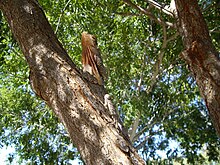
The frilled lizard is adiurnal(daytime) andarborealspecies,[8]spending over 90% each day up in the trees. It spends as little time on the ground as possible, mostly to feed, interact socially, or to travel to a new tree. Males move around more, 69 m (75 yd) per day on average versus 23 m (25 yd) for females atKakadu National Park.[10]In the same area, male lizards were found to have an averagehome rangeof 1.96 ha (4.8 acres) during thedry seasonand 2.53 ha (6.3 acres) during thewet season;females used 0.63 ha (1.6 acres) and 0.68 ha (1.7 acres) for the wet and dry seasons, respectively.[10][22]Male lizards assert their boundaries with frill displays.[15]Frilled lizards are capable of movingbipedallyand do so while hunting or to escape from predators. To keep balanced, they lean their heads far back enough, so it lines up behind the tail base.[10][12][18]
These lizards are more active during the wet season, when they select smaller trees and are more commonly seen near the ground; during the dry season, they use larger trees and are found at greater heights.[23]Frilled lizards do not entertorpidityduring the dry season, but they can greatly reduce their energy usage and metabolic rate in response to less food and water.[24]Body temperatures can approach 40 °C (104 °F).[10]The species willbaskvertically on the main tree trunk in the morning and near the end of the day,[10][25]though in the dry season they cease basking at a lower body temperature to better maintain energy and water.[25][26]When it gets hotter during day, they climb higher in the canopy for shade.[10]Frilled lizards will use large trees andtermitemounds as refuges duringwildfires.After a forest is burnt, the lizards select trees with more continuous canopies.[21]
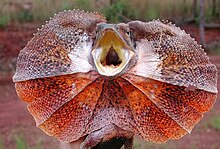
Frilled lizards primarily feed on insects and other invertebrates, and very rarely take vertebrates. Prominent prey includes termites,antsandcentipedes;termites are particularly important food during the dry season, andmothlarvae become important during the wet season.[23]Consumption of ants drops after early dry season fires but rises following fires later in the season.[21]This species is asit-and-wait predator:it watches for potential prey from a tree and, upon seeing it, climbs down and rushes towards it on two legs before descending on all four to grab and eat it. After feeding, it retreats back up a tree.[10]
Frilled lizards face threats frombirds of preyand larger lizards and snakes.[10][18]When threatened, the species erects its frill to make itself look bigger. This display is accompanied by a gaping mouth, puffing, hissing, and tail lashes. The lizard may also flee and hide from its predators.[18]Several species ofnematodeinfest the gastrointestinal tract.[27]There is at least one record of an individual dying ofcryptosporidiosis.[28]
Frilled lizards can breed during the late dry and early wet seasons.[10]Competing males display with gaping mouths and spread frills. Fights can ensue, in which the lizards pounce and bite each other's heads.[15]The female digs a shallow cavity to leave her eggs.[29][30]They can lay multipleclutchesper season, and the number of eggs in a clutch can vary from four to over 20.[10][29]The incubation period can last two to four months,[29][30]with milder temperatures producing more males and more extreme temperatures producing more females.[30]Hatchlings have proportionally smaller frills than adults.[15]Lizards grow during the wet season when food is more abundant,[23]and males grow faster than females.[31]Juvenile males also disperse further from their hatching area.[32]The species reaches sexual maturity within two years; males live up to six years compared to four years for females.[22]
Conservation[edit]
TheInternational Union for Conservation of Naturelists the frilled lizard as ofleast concern,due to its abundance and wide range, but warns that its population may be locally declining in some areas. It is a popular species in the pet trade, which may threaten some wild populations. Most pet lizards appear to come from Indonesia, as export of them is banned in Australia and Papua New Guinea.[1]Nevertheless, the Indonesian government themselves have allocated the frilled lizard as a protected species under the Article 20 of the Environment and Forestry Ministerial Regulation On Types of Protected Plants and Animals.[33]Being difficult to breed in captivity, many presumed captive bred lizards are likely to have been taken from the wild. Frilled lizards may also be threatened by feral cats,[1]though they do not appear to be significantly affected by the invasivecane toad.[34]
Relationship with humans[edit]
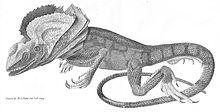
The frilled lizard is considered to be among the most iconic Australian animals along with thekangarooandkoala.[10]Archaeological evidence indicates that frilled lizards were eaten by someindigenous peoplesin ancient times.[35]In the late 19th century,William Saville-Kentbrought a live lizard to England where it was observed by fellow biologists. Another specimen was kept at a reptile display in Paris, as reptiles were becoming more popular in captivity.[2]
Because of its unique appearance and behaviour, the creature has often been used in media. InSteven Spielberg's 1993 filmJurassic Park,the dinosaurDilophosauruswas portrayed with a similar neck frill that rose when attacking.[14]Its image has been used in the 1994LGBT-themed filmThe Adventures of Priscilla, Queen of the Desert.[36]The species has been featured on some Australian coins.[10]
References[edit]
- ^abcdeO'Shea, M.; Allison, A.; Tallowin, O.; Wilson, S.; Melville, J. (2017)."Chlamydosaurus kingii".IUCN Red List of Threatened Species.2017:e.T170384A21644690.doi:10.2305/IUCN.UK.2017-3.RLTS.T170384A21644690.en.Retrieved19 November2021.
- ^abOlsen, Penny (2010).Upside Down World: Early European Impressions of Australia's Curious Animals.National Library of Australia. p. 196.ISBN978-0-642-27706-0.
- ^Kent, William Saville(2017) [1897].The Naturalist in Australia.Chapman & Hall. pp.70–73.ISBN978-3-337-31163-6.
- ^Guyot, Arnold; Barnard, Frederick Augustus Porter; Johnson, A. J.; et al. (1890).Johnson's Univeral Cyclopædia A Scientific and Popular Treasury of Useful Knowledge · Volume 2.A. J. Johnson. p. 64.OCLC5392794.
- ^Beolens, Bo; Watkins, Michael; Grayson, Michael (2011).The Eponym Dictionary of Reptiles.Johns Hopkins University Press. p. 141.ISBN978-1-4214-0135-5.
- ^abcdefCogger, Harold G. (2014).Reptiles & Amphibians of Australia(7th ed.). CSIRO publishing. pp. 700–701.ISBN978-0-643-10035-0.
- ^Hugall, A. F.; Foster, R.; Hutchinson, M.; Lee, M. S. Y. (2008)."Phylogeny of Australasian agamid lizards based on nuclear and mitochondrial genes: implications for morphological evolution and biogeography".Biological Journal of the Linnean Society.93(2): 343–358.doi:10.1111/j.1095-8312.2007.00911.x.
- ^abcdefgPepper, Mitzy; Hamilton, David G.; Merkling, Thomas; Svedin, Nina; Cser, Bori; Catullo, Renee A.; Pryke, Sarah R.; Keogh, J. Scott (2017)."Phylogeographic structure across one of the largest intact tropical savannahs: Molecular and morphological analysis of Australia's iconic frilled lizardChlamydosaurus kingii"(PDF).Molecular Phylogenetics and Evolution.106:217–227.Bibcode:2017MolPE.106..217P.doi:10.1016/j.ympev.2016.09.002.PMID27664346.
- ^Pyron, R. A.; Burbrink, F. T.; Wiens, J. J. (2013)."A phylogeny and revised classification of Squamata, including 4161 species of lizards and snakes".BMC Evolutionary Biology.13(1): 93.Bibcode:2013BMCEE..13...93P.doi:10.1186/1471-2148-13-93.PMC3682911.PMID23627680.
- ^abcdefghijklmnopShine, R; Lambeck, R (1989). "Ecology of frillneck lizards,Chlamydosaurus kingii(Agamidae), in tropical Australia ".Australian Wildlife Research.16(5): 491–500.doi:10.1071/WR9890491.
- ^Frappell, P. B.; Mortola, J. P. (1998)."Passive body movement and gas exchange in the frilled lizard (Chlamydosaurus kingii) and goanna (Varanus gouldii) ".Journal of Experimental Biology.201(15): 2307–2311.doi:10.1242/jeb.201.15.2307.PMID9662501.
- ^abcThompson, G. G.; Withers, P. C. (2005)."Shape of Western Australian dragon lizards (Agamidae)".Amphibia-Reptilia.26:73–85.doi:10.1163/1568538053693323.
- ^Christian, K; Bedford, G; Griffiths, A (1995). "Frillneck lizard morphology: comparisons between sexes and sites".Journal of Herpetology.29(4): 576–583.doi:10.2307/1564741.JSTOR1564741.
- ^abcdMontandon, S. A.; Fofonjka, A; Milinkovitch, M. C. (2019)."Elastic instability during branchial ectoderm development causes folding of theChlamydosauruserectile frill ".eLife.8:e44455.doi:10.7554/eLife.44455.PMC6592688.PMID31234965.
- ^abcdefgShine, R (1990). "Function and evolution of the frill of the frillneck lizard,Chlamydosaurus kingii(Sauria: Agamidae) ".Biological Journal of the Linnean Society.40(1): 11–20.doi:10.1111/j.1095-8312.1990.tb00531.x.
- ^Pepper, Mitzy; Hamilton, David G.; Merkling, Thomas; Svedin, Nina; Cser, Bori; Catullo, Renee A.; Pryke, Sarah R.; Keogh, J. Scott (January 2017)."Phylogeographic structure across one of the largest intact tropical savannahs: Molecular and morphological analysis of Australia's iconic frilled lizard Chlamydosaurus kingii".Molecular Phylogenetics and Evolution.106:217–227.Bibcode:2017MolPE.106..217P.doi:10.1016/j.ympev.2016.09.002.PMID27664346.
- ^Peacock, J; Benson, M. A.; Greene, N. T.; Tollin, D. J.; Young, B. A. (2022). "The acoustical effect of the neck frill of the frill-necked lizard (Chlamydosaurus kingii) ".The Journal of the Acoustical Society of America.152(1): 437.Bibcode:2022ASAJ..152..437P.doi:10.1121/10.0012221.PMID35931550.S2CID250592592.
- ^abcdPerez-Martinez, C. A.; Riley, J. L.; Whiting, M. J. (2020). "Uncovering the function of an Enigma tic display: antipredator behaviour in the iconic Australian frillneck lizard".Biological Journal of the Linnean Society.129(2): 425–438.doi:10.1093/biolinnean/blz176.
- ^abMcLean, C. A.; Lutz, A.; Rankin, K. J.; Elliot, A.; Moussalli, A.; Stuart-Fox, D. (2019)."Red carotenoids and associated gene expression explain colour variation in frillneck lizards".Proceedings of the Royal Society B: Biological Sciences.286(1907): 20191172.doi:10.1098/rspb.2019.1172.PMC6661345.PMID31311479.
- ^Hamilton, D.G.; Martin, J. W.; Pryke, S.R. (2013)."Fiery frills: carotenoid-based coloration predicts contest success in frillneck lizards".Behavioral Ecology.24(5): 1138–1149.doi:10.1093/beheco/art041.(Retracted, seedoi:10.1093/beheco/ary014)
- ^abcGriffths, A. D.; Christian, K. A. (1996). "The effects of fire on the frillneck lizard (Chlamydosaurus kingii) in northern Australia".Australian Journal of Ecology.21(4): 386–398.doi:10.1111/j.1442-9993.1996.tb00625.x.
- ^abGriffiths, A. D. (1999). "Demography and home range of the frillneck lizard,Chlamydosaurus kingii(Agamidae), in Northern Australia ".Copeia.1999(4): 1089–1096.doi:10.2307/1447984.JSTOR1447984.
- ^abcGriffith, A. D.; Christian, K. A. (1996). "Diet and habitat use of frillneck lizards in a seasonal tropical environment".Oecologia.106(1): 39–48.Bibcode:1996Oecol.106...39G.doi:10.1007/BF00334405.PMID28307155.S2CID7046330.
- ^Christian, K. A.; Griffiths, A. D.; Bedford, G. S. (1996). "Physiological ecology of frillneck lizards in a seasonal tropical environment".Oecologia.106(1): 49–56.Bibcode:1996Oecol.106...49C.doi:10.1007/BF00334406.JSTOR4221230.PMID28307156.S2CID25400682.
- ^abChristian, K. A.; Bedford, G. S. (1995). "Seasonal changes in thermoregulation by the frillneck lizard,Chlamydosaurus kingii,in tropical Australia ".Ecology.76(1): 124–132.doi:10.2307/1940636.JSTOR1940636.
- ^Christian, K; Green, B (1994). "Seasonal energetics and water turnover of the frillneck lizard,Chlamydosaurus kingii,in the wet-dry tropics of Australia ".Herpetologica.50(3): 274–281.JSTOR3892700.
- ^Jones, H. I. (1994). "Gastrointestinal nematodes of the frillneck lizard,Chlamydosaurus kingii(Agamidae), with particular reference toSkrjabinoptera goldmanae(Spirurida: Physalopteridae) ".Australian Journal of Zoology.42(3): 371–377.doi:10.1071/ZO9940371.
- ^Orós, J; Rodríguez, J. L.; Patterson-Kane, J (1998)."Gastric cryptosporidiosis in a wild frilled lizard from Australia".Journal of Wildlife Diseases.34(4): 807–810.doi:10.7589/0090-3558-34.4.807.PMID9813853.S2CID20958564.
- ^abcGriffiths, A. D. (1993). "Preliminary investigations on the reproduction of the frillneck lizardChlamydosaurus kingiiin the Northern Territory ".Herpetology in Australia: A Diverse Discipline.Transactions of the Royal Zoological Society of NSW. pp. 127–131.ISBN0-9599951-8-8.
- ^abcHarlow, P; Shine, R (1999). "Temperature-dependent sex determination in the frillneck lizard,Chlamydosaurus kingii(Agamidae) ".Herpetologica.55(2): 205–212.JSTOR3893081.
- ^Ujvari, B; Fisher, P; Rydell, J; Wahlgren, R; Wright, B; Madsen, T (2014). "Population demography of frillneck lizards (Chlamydosaurus kingii,Gray 1825) in the wet-dry tropics of Australia ".Austral Ecology.40(1): 60–66.doi:10.1111/aec.12168.
- ^Ujvari, B; Dowton, M; Madsen, T (2008)."Population genetic structure, gene flow and sex-biased dispersal in frillneck lizards (Chlamydosaurus kingii) ".Molecular Ecology.17(15): 3557–3564.doi:10.1111/j.1365-294X.2008.03849.x.PMID19160482.S2CID1299295.
- ^"Peraturan Menteri Lingkungan Hidup dan Kehutanan Nomor P.106/Menlhk/Setjen/Kum.1/12/2018 tentang Perubahan Kedua Atas Peraturan Menteri Lingkungan Hidup dan Kehutanan Nomor P.20/Menlhk/Setjen/Kum.1/6/2018 tentang Jenis Tumbuhan dan Satwa Yang Dilindungi"(PDF)(in Indonesian).Ministry of Environment and Forestry.28 December 2018 – viaMongabay.
- ^Ujvari, B; Shine, R; Madsen, T (2011). "Detecting the impact of invasive species on native fauna: Cane toads (Bufo marinus), frillneck lizards (Chlamydosaurus kingii) and the importance of spatial replication ".Austral Ecology.36(2): 126–130.Bibcode:2011AusEc..36..126U.doi:10.1111/j.1442-9993.2010.02126.x.
- ^Schrire, C. (1982).The Alligator Rivers: prehistory and ecology in Western Arnhem Land.Terra Australis. pp. 90, 123.ISBN0-86784-204-0.
- ^Paige, L. R. (2016)."Drag queens, thorny devils and frilled lizards:" queerness "takes to the outback in The Adventures of Priscilla, Queen of the Desert".Reconstruction: Studies in Contemporary Culture.16(2).

